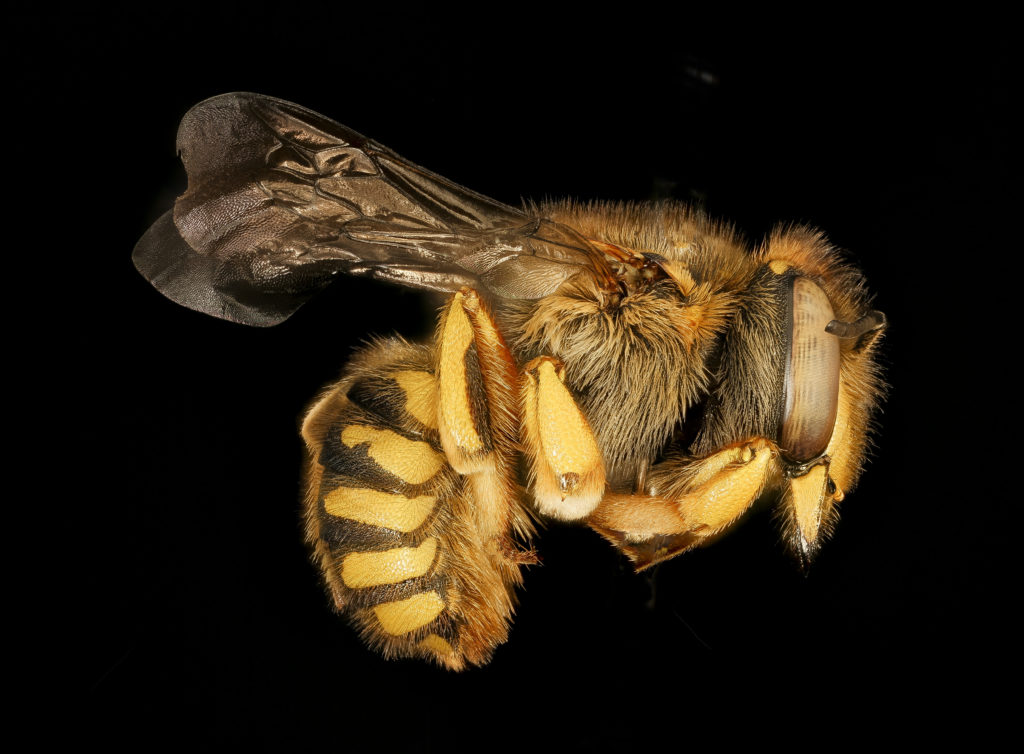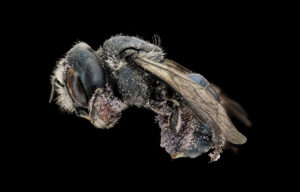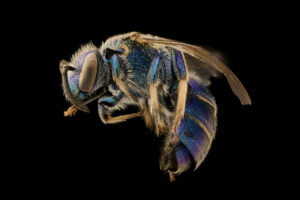From the CNGA Women in Horticulture Presentation by Dr. Gabriela Chavarria
Halloween without pumpkins?
Thanksgiving without cranberries?
Dessert without chocolate?
Most of the food that we eat is produced naturally. If it’s produced naturally, it involved a pollinator. It involved an animal that brought it to your table. Bees are our heroes. We take them for granted and they are disappearing.
I do love honey bees, but there is a place for all species. We all know, and you will see some scientific data shows, that honey bees are really harmful to some native ecosystems, especially urban ecosystems.
Pollination is a process that occurs 24 hours a day, 365 days a year, because there will be a pollinator somewhere, day or night, that is pollinating. And the diversity of pollinators is so rich, including not only insects but a lot of small mammals, lizards, bats… There are some incredible pollinators.
Certainly bees are the best pollinators because they are strictly designed to pollinate. They’re vegetarian so they only feed on nectar and pollen. That’s their job and the beauty of them is that they have special structures in their legs so they can collect the pollen and bring it back to the colony or move it from flower to flower.
There’s a beautiful documentary by the BBC that came out in 1981, and it’s one of my favorite films. You can probably YouTube it. It’s called “Sexual Encounters of the Floral Kind,” and it is just an incredible, incredible film that shows how plants have to make these incredible sacrifices to really attract the perfect pollinator. Without their pollinators, many plants will not survive. Also, for a lot of these insects and mainly a lot of the bees, without that specific plant, they will not survive. They have this co-evolution. They grow together. So if that plant dies, they die too.
But, bumblebees love everything. They love all kinds of pollen. In fact, now we know they can be a problem if you have invasive plant species, because the bees move with the invasive species. They will just go after the pollen. They don’t have any restriction on their diets. It’s like if you were lost on an island with broccoli and you happen to hate broccoli. I’m telling you: after a week you will be eating broccoli. And it’s the same with a lot of these bee species. Invasive plant species like to take over and then the bees just get used to it and just expand the pollination of a lot of these unwanted plants.

The Diversity of Pollinators
Bumblebees are also very diverse. Worldwide there are about 250 different species of bumblebees. In the United States, we have 54. And here in Colorado, we probably have between 22 and 24. We have a great fauna of bumblebees, and we have a great fauna of native bees. Colorado is second to California in terms of native bee species. We have 940 species.
That does not include the honey bee because the honey bee is not native to this continent. Honey bees came from Europe. They were brought in by the first colonizers in their second ship, because they realized, “Oh my God, there’s no honey bees. Who’s going to pollinate our crops?” So, they had to bring the native pollinators to pollinate their crops. The idea was they would pollinate the European crops that we continue to grow all across this country. But, they were not brought in to pollinate native plants, and native plants were not designed to receive honey bees. In fact, most of them are not even designed to receive so many pollinators at once. They can handle one or two. Sometimes depending on the size of the flower they may be able to take three. But, if you suddenly have a honey bee hive close by, your native plant will get 10, 15, or 20 bees. They are all fighting for that resource and because they are not specifically designed to pollinate that plant, they’re not pollinating. They are just taking pollen and nectar that belongs to another species that really needs that resource.
I told you about the famous corbicula, or the pollen basket (on the bee’s legs). Some bees are just incredible. The amount of pollen they can carry is just fascinating. They will brush the pollen, add a little bit of the nectar, and continue adding more and more pollen. Then, they just fly everywhere. Because they are covered with hairs, the pollen gets everywhere.
We have a great resource that was released recently, a poster called “Backyard Bees of North America”. It’s really impressive because people don’t realize the amount of native bees that we have.
Bees come in all different sizes from the size of my little nail to the big carpenter bees with metallic colors. Not all bumblebees are black and yellow. They come in white and black or white and yellow. So, next time you are in the gardens, and I am sure you have seen it already, just look closely. The beauty also is that most of these species do not sting. The only bees that sting are honey bees that die when they sting and then bumblebees. Bumblebees hardly ever will sting you unless you go into their hive.
One of my favorite bees is not native to the United States. They are native to tropical areas of America. These are famously called orchid bees and they only pollinate the orchids in Central and South America. They are just absolutely beautiful and if you see that film, “Sexual Encounters”, you will see an example of these bees. The males collect the resins and oils from the orchids to create perfume to attract the females, so they are just beautiful metallic bees.

The Scarcity of Bees
We need bees, because without bees and without plants and flowers, we wouldn’t be eating and we wouldn’t have these beautiful ecosystems that we are surrounded by. The partnership and the association is really incredible, really unique. You don’t see a lot of these partnerships happening in our ecosystems.
Just imagine life without bees, and it’s already happening. We already have a lot of plant species that we have to help pollinate.
In China already, most of the apples grown there, particularly Gala, are hand pollinated. The U.S. Department of Agriculture has mandated that every single apple has to have a label and tell you where that apple comes from. Pollinating by hand, that’s ok, but they are hand pollinated in China because the amount of pesticides that they use has killed the pollinators. A lot of Chinese workers get horrible burns from the pesticides.
Many years ago, I was part of an international pollinator initiative of the United Nations, and we were trained to reintroduce pollinators in various areas of the world. When we talked to the Chinese government, they said, “No. What will we do with 40,000 Chinese workers that their only job is to hand pollinate the apples? No, we don’t care about your free service bees. We just don’t have any other kind of employment.”
So, a lot of these apples, I don’t know if they are still coming into the United States but, they were banned for a little while. Hand pollination is a very different process than having an animal pollinate it.

Another example is with the yellow-masked bees that are native to Hawaii, but they are endangered. Some native plants had to be pollinated because some of these bees are probably extinct. A lot of these plants grow on cliffs, so for a while, a lot of the wildlife biologists would hang from a helicopter to hand pollinate these plants.
We have a lot of species that we don’t know if they have disappeared because we’re not paying enough attention to our ecosystems. So, I really invite you next year when you start growing to observe what is coming to your flowers, because you can build a lot of really great data about the numbers of bees and native bees. You are out there and probably see them all the time.
We know the bees are dying and not only the honey bees, but all bees are dying. Fifty-five percent of America’s fruits, nuts and vegetables are shipped from California and not all of the farms and groves grown in California are organic. The majority of them are industrialized farming. And most of northern California grows almonds. Almonds are not native. We have hundreds of thousands of acres planted with almonds in an area of the country that is so dry and almonds require so much water. Not only that, you need the pollinator so they bring hundreds of thousands of bees, honey bees, that have to pollinate the almonds. Any other bee will not help produce fruit. It has to be honey bees and we don’t have enough honey bees anymore to do agricultural work. A lot of our honey bees now are in urban settings. So we’re missing them from their cultural places where we need them, because 90% of the planet’s wild plants and 30% of our crops depend on cross pollination.

Three Threats to Bee Species
Pests continue to be a threat not only to bees but to a lot of wildlife and to us. Some mites are killing honey bees and other mites are killing bumblebees and other native species. A lot of these invasive mites are coming through the different industries with crops, even with plants, when we bring plants from other countries. The inspection service is just not adequate. You can actually see these mites if you have a honey bee hive. You have the famous trachial mite, which in a matter of hours can destroy your whole hive because these mites reproduce in a matter of minutes inside the bees.
Another big threat is the migratory beekeeping. We don’t have enough bees to pollinate a lot of our agricultural crops, so we have to ship and move bees. They usually spend their winters in Vermont. Then at the beginning of the season, which is usually the almonds in California that only flower for about two weeks, these bees will be trucked, hundreds of hives will be trucked across country to pollinate the almonds. After they feed on the almonds, the flowers are gone so they have to take them somewhere else. They usually go up to pollinate apples in Washington state. Then they cross the country to pollinate cotton in Texas, then they go out to Florida to pollinate citrus. Finally, they go up again towards Vermont, pollinating a lot of the berries.
These bees, which are organisms that have to be flying, they are in a truck, and you have hive after hive piled up. They do not have enough food along the way so corn sugar solutions or corn syrup is fed to them. In order to avoid diseases, many are given antibiotics. So, we have created a big problem, because our ecosystems and the way we grow agriculture in these monocultures are not allowing bees to stay in one place all year long.

Then urban beekeeping — as much as I would like to say it’s good — is not good. Because you are growing bees in a city where most of us tend to plant native plants, so we are not attracting the native pollinator. If you are a single solitary bee and you are coming out of the ground and you are like, “Oh my god, that is my favorite flower!” And you are trying to get to your flower and suddenly that flower is full of honey bees, and you don’t have a way to fight the honey bees. Honey bees are really displacing a lot of our native species.
Canada just released a big report early in the summer about all of their urban beekeeping honey. They discovered a huge amount of pollutants in the honey. Just imagine where these bees fly to. I love going to lunch at the Brown Palace (in Denver) and the servers tell me, “Oh, this is our local honey.” And I’m like, “Oh, no, no, no.” And they’re like, “No?”
Do you know where your bees go and collect water? Civic park? I don’t think so. Because bees go and collect water and they go and find the water that is closer. They don’t even know if it’s gasoline. It’s liquid so they go and collect it. So, you don’t want to know how many different pollutants you are finding in this honey.
The United States has refused to test our honey, but Canada did it. Urban beekeeping has become a hobby practice. People are trying to protect pollinators but we need to get the story straight, so we can help the species that really belong here and that are helping our ecosystems.
Ways to Save the Bees
A lot of you participate in gardens, so try to create a lot of habitat for our pollinators. When your landscape lacks diversity, just imagine it from a bee’s perspective. You come out and you are like, “Oh my god, where is the food?” A lot of people and places are starting to redesign ecosystems, even golf courses, believe it or not. This Robert Trent Jones course in Virginia is one of the most environmental golf courses in the world. They use zero pesticides and they have restored all of their native habitats, and turned it into a really beautiful place.
Wildflowers always help in gardens. They always create food.
I don’t know how many of you have seen bee condominiums. They are just perfect because a lot of these bees are just looking for a habitat, a place to live. You can make it on your own. Companies also sell them. Just remember every year to clean them, because bees are very clean. If your house is not clean, they will not move in. You have to clean it every year and that way they will return.
A lot of bees are also ground dwellers. If you have soft soil around the garden and some places, they love to build their holes. They don’t need a lot of space. You will not just see one hole but you will see several. Because although they like to be independent, they like to be surrounded by friends, so they each have their own home, but they have friends all around. And they are just absolutely beautiful.
There’s a lot of campaigns to protect pollinators. There’s a lot of initiatives in Colorado and nationwide, really trying to promote pollinators. The North American Pollinator Protection Campaign is a tri-national initiative with Canada, Mexico and the U.S.
And of course, education is necessary. We need to do more and more education, especially for the younger generations. If you are not familiar with the XERCES Society, they are the only society in the world that protects invertebrates. They have really great resources.
There’s a famous initiative called Bee City USA, in which cities can adopt environmentally friendly practices to get certification. There’s already a lot of cities that have tried and have succeeded.
The Garden Challenge is a nationwide program where gardens participate to create the best pollinator habitats and then measure whether pollinators are coming into those gardens.
I would like to end with a quote from one of my mentors, E. O. Wilson. In his forward to the book, “The Forgotten Pollinators”, published in 1997, he wrote, “Humanity, for its own sake, must attend to the forgotten pollinators and their countless dependent plant species.”
If you read that book today, we are talking about exactly the same threats, so we have not moved the needle. And we have to start moving that needle in order to protect these species.










